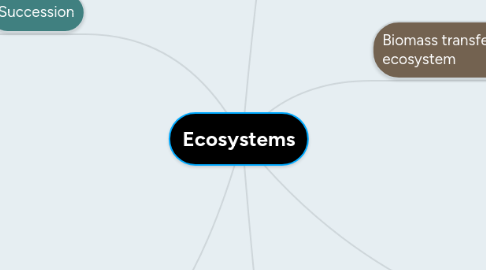
1. Succession
1.1. Stages of succession
1.1.1. Pioneer community
1.1.1.1. Pioneer species colonise inhospitable environments, able to produce large quantities of spores/seeds which are deposited by wind, germinate rapidly, autotrophic, tolerate extreme climates, fix nitrogen
1.1.2. Intermediate community
1.1.2.1. Humus supports new species e.g. mosses which arrive via spores or seeds --> decomposition of organisms makes abiotic factors more favourable for new species --> new species are better adapted and tend to outcompete earlier species
1.1.3. Climax community
1.1.3.1. Stable state, type of species present depends on climate, not most biodiverse stage of succession as dominant species become more successful in elimination of others
1.2. Animal succession
1.2.1. Normally much slower than plant succession
1.3. Deflected succession
1.3.1. Plagioclimax = when succession is halted artificially
1.3.1.1. Grazing and trampling of vegetation by domesticated animals --> large areas remain as a grassland
1.3.1.2. Removing existing vegetation to plant crops --> crops become final community
1.3.1.3. Burning as a means of forest clearance --> increases biodiversity as it provides space and nutrient-rich ash for other species to grow
2. Measuring the distribution and abundance of organisms
2.1. Distribution of organisms
2.1.1. Measuring distribution
2.1.1.1. Line or belt transect (more information) is used. Systematic sampling allows scientists to study how
2.1.2. Usually uneven
2.2. Abundance of organisms
2.2.1. Measuring abundance
2.2.1.1. Measuring plant abundance
2.2.1.2. Measuring animal abundance
2.2.2. Immigration + births increase, emigration and deaths decrease
3. organic compound is broken down into smaller inorganic molecules (nutrients), decomposers secrete enzymes onto dead organisms/organic waste matter and absorb them, releasing stored inorganic compounds. detritivores feed on detritus and increase surface area for decomposers, they digest internally
4. Ecosystems
4.1. Defining ecosystems
4.1.1. interactions between living organisms + organisms that once lived e.g. competition for food, space, breeding partners
4.1.2. ecosystem --> made up of all living organisms that interact with each other in a defined area, and physical factors present in that region, can vary dramatically in size
4.2. Factors that affect ecosystems
4.2.1. Biotic factors
4.2.2. Abiotic factors
4.2.2.1. Light
4.2.2.1.1. bc light is needed for photosynthesis, more light = more success for plant species, develop strategies to cope i.e. larger leaves, photosynthetic pigments that require less light, reproductive systems that only operate when light intensity is at optimum
4.2.2.2. Temperature
4.2.2.2.1. affects enzymes controlling metabolic reactions, develop more rapidly at higher temps, changes in temp --> migration/hibernation/leaf-fall/dormancy/flowering
4.2.2.3. Water availability
4.2.2.3.1. lack of water --> water stress --> death, needed for photosynthesis, xerophytes are successfully adapted to lack of water
4.2.2.4. Oxygen availability
4.2.2.4.1. fast-flowing + cold = more oxygen, waterlogged --> air spaces filled with water = less oxygen available
4.2.2.5. Edaphic factors
4.2.2.5.1. clay --> fine particles, easily waterlogged, clumps when wet. loam --> different sized, retains water but not waterlogged. sandy --> coarse, well-separated, allows free draining, doesn't retain water + easily eroded
4.2.3. can be equated to energy content --> multiply biomass of each organism by no. of organisms, doesn't take into account seasonal changes, presence of various amounts of water in each organism --> unreliable, dry mass = evaporated animals --> only small amount taken to reduce ethical problems --> not representative of whole population
5. Biomass transfer through an ecosystem
5.1. Trophic levels
5.1.1. rarely more than 4 bc there is not enough biomass + stored energy to provide for further organisms
5.2. Measuring biomass
5.3. Human activities can manipulate biomass through ecosystems
5.3.1. Efficiency at producer level
5.3.1.1. not all solar energy is used for photosynthesis --> reflected, transmitted through leaf, wrong wavelength etc. other factors limit photosynthesis, some energy is lost through photosynthetic reactions
5.4. Efficiency of biomass and energy transfers between trophic levels
5.4.1. Efficiency at consumer level
5.4.1.1. not all biomass is eaten. some energy is transferred to environment as heat. some biomass is indigestible and passed as faeces. energy is lost through urine.
6. Recycling within ecosystems
6.1. Decomposition
6.2. Recycling nitrogen
6.2.1. Nitrogen fixation
6.2.1.1. Azotobacter and Rhizobium contain nitrogenase which combines nitrogen gas with hydrogen --> ammonia which can be absorbed + used by plants. A = free living, R = in root nodules --> symbiotic mutualistic } plants gain amino acids + bacteria gains carbohydrates through photosynthesis
6.2.2. Nitrification
6.2.2.1. Nitrosomonas oxidises ammonia into nitrites and Nitrobacter oxidises nitrites into nitrates (highly soluble, so taken in by plant)
6.2.3. Denitrification
6.2.3.1. In anaerobic situations, nitrates used as a source of respiration for bacteria + nitrogen gas is produced (waterlogged soil)
6.2.4. Ammonification
6.2.4.1. Decomposers turn nitrogen containing molecules (dead matter) into ammonium compounds
6.2.5. Nitrogen cycle
6.3. Recycling carbon
6.3.1. Carbon dioxide is the main source of carbon (0.04%)
6.4. Fluctuations in atmospheric carbon dioxide
6.4.1. photosynthesis removes CO2 in the day (light availability is highest), respiration occurs throughout day at constant --> CO2 is highest at night } lower in the summer when temp is higher (photosynthesis is also higher)
6.4.2. combustion of fossil fuels + deforestation has increased CO2 levels --> traps more thermal energy --> less gas is dissolved in seas + more is in the air -->
